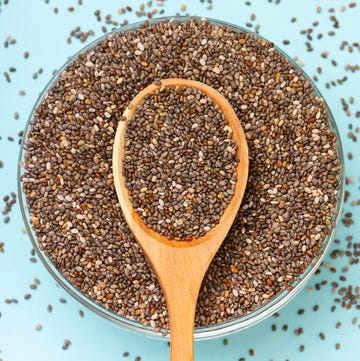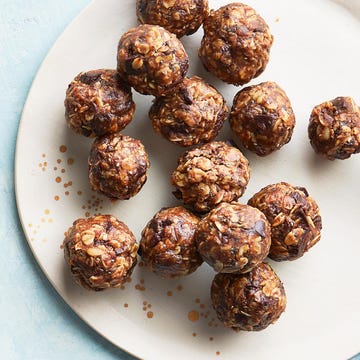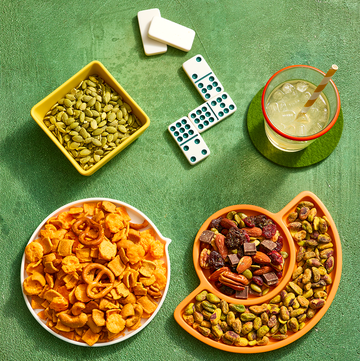When it comes to nutrition, some of the most powerful foods come in the smallest packages — and flaxseeds are a perfect example. These teeny, tiny seeds have taken the wellness world by storm and for good reason: They may be small, but their health benefits are mighty.
Flaxseeds are rich in fiber, omega-3 fatty acids, plant-based protein and a handful of other essential vitamins and minerals, so whether you’re looking to improve your heart health, support your digestion or simply add a nutritional boost to your day, flaxseeds provide a simple way to check all the boxes. And best of all, their mild, nutty flavor makes them easy to add to just about everything from smoothies to salads to baked goods.
Ahead, we break down the top science-backed benefits of flaxseeds and share simple, creative ways to incorporate them into your daily routine.
What are flaxseeds?
Flaxseeds are the edible seeds of the flax plant, a blue-flowered perennial plant that is thought to be one of the oldest cultivated crops. Historically grown for its fibrous stalks (early American colonists used them to make clothing and textiles), today in North America, the plant is grown primarily for its seeds.
Small, shiny and typically brown or golden in color, flaxseeds are true nutritional powerhouses. They’re rich in fiber, which means they can help you feel fuller for longer, support healthy blood sugar and cholesterol levels and relieve constipation. They also deliver a good dose of plant-based protein, along with antioxidants and essential minerals like iron, potassium and magnesium.
One of flaxseeds' standout nutrients is alpha-linolenic acid (ALA) — an essential omega-3 fatty acid known for its heart-health benefits. ALA has been linked to reduced inflammation, lower cholesterol and a decreased risk of cardiovascular disease. In fact, flaxseeds are the richest plant-based source of ALA: One tablespoon of whole flaxseeds contains about 2.4 grams, while the same amount of flaxseed oil has 7.3 grams. For comparison, almonds contain only 0.4 grams of ALA per tablespoon and a tablespoon of olive oil, just 0.1 grams.
What’s more, flaxseeds are also the highest food source of lignans, a plant compound that has been associated with the prevention of chronic illnesses, including some types of cancer and cardiovascular disease.
While there’s no official dietary recommendation for flaxseeds, many nutrition experts recommend incorporating 1 to 2 tablespoons per day to start tapping into their impressive health benefits.
Flaxseeds nutrition (1 tablespoon, dry, ground) per the USDA:
- 37 calories
- 3g total fat
- 2g total carbohydrates
- 2g dietary fiber
- 1g protein
What are the best ways to eat flaxseeds?
Flaxseeds are available in two main forms: whole seeds and ground (often sold as flaxseed meal). While both offer nutritional value, most experts recommend opting for ground. That's because the crushed form is much easier for your body to digest, with more bioavailable nutrients. Whole seeds can actually pass through your system undigested, meaning your body can't access the omega-3 containing oil and you may miss out on much of the seeds' nutritional goodness.
Here are some easy (delicious!) ways to add these tiny seeds to your daily diet:
- Blend whole or ground flaxseeds into smoothies
- Sprinkle flaxseed meal on top of your favorite yogurt, cereal or smoothie bowls
- Stir some into hot oatmeal, overnight oats, energy bites or granola
- Make a vegan flax "egg" by whisking together 1 tablespoon ground flaxseeds with 2 tablespoons water
- Bake into muffins, cookies or breads
- Mix into meatballs, burger patties, taco filling or meatloaf
- Drizzle flaxseed oil on top of salads or use it in homemade vinaigrettes
Can you grind your own flaxseeds?
Absolutely. If you only have whole flaxseeds on hand, fear not — you can easily grind them at home using a coffee grinder, high-powered blender or food processor. In fact, since whole flaxseeds are generally less expensive than pre-ground flaxseeds, sometimes your best bet is to buy them whole and grind what you need, when you need it.
A general rule of thumb is that ground flaxseeds will approximately double in volume compared to whole flaxseeds. So if a recipe calls for ¼ cup of ground flaxseed, you should grind about ⅛ cup (2 tablespoons) worth of whole flaxseeds.
How should you store flaxseeds?
Because of their high omega-3 content, flaxseeds are more prone to spoilage compared to other pantry staples. You can keep unopened bags of flaxseeds in a cool, dark and dry place, such as your pantry. Once opened though, store flaxseeds in the fridge or freezer in an airtight, opaque container for maximum freshness.
Because they have been processed, ground flaxseeds generally have a shorter shelf life than whole flaxseeds. Ground flaxseeds are best stashed in the freezer, again, in an airtight, opaque container, to keep them fresh until you’re ready to use them.
Flaxseed oil should also be stored in the fridge and used within a few weeks of opening.
Are there any risks to eating flaxseeds?
Just like with anything, moderation is key. Due to their high fiber content, eating too many flaxseeds — especially too quickly — can lead to digestive issues. As with all high-fiber foods, make sure to drink plenty of water to help the fiber properly digest and try to increase your fiber consumption gradually so your digestive system isn’t overwhelmed.
In addition, flaxseeds may interact with blood thinners, blood pressure and diabetes medications, as well as some oral contraceptives. Moreover, certain compounds in flaxseeds can also mimic estrogen, which means that people on hormone therapy, those with hormone-sensitive cancers or pregnant or nursing women should avoid eating too many flaxseeds. If you fall into any of those categories, consult your doctor before making flaxseeds a regular part of your diet.














